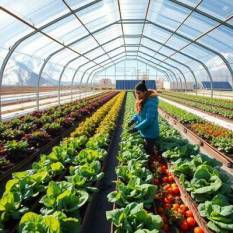LEH, 20 June 2025: In the icy reaches of Ladakh, where the mercury regularly dips below –30°C, farmers are growing vegetables not just in summer—but even under snow. Thanks to cutting-edge greenhouse innovations, year-round farming is becoming a reality in India’s cold desert.
High-altitude farming has always been limited by short growing seasons, small landholdings, and extreme temperatures. But technologies like passive solar greenhouses, trench systems, and low tunnels have revolutionised Ladakhi agriculture by creating controlled micro-environments for crops.
“Protected cultivation is now transforming food and nutritional security in the region,” M.S. Kanwar, Principal Scientist at ICAR-CAZRI, Leh said.
Evolution of Protected Cultivation
The journey began in 1964 when the Defence Institute of High Altitude Research (DIHAR) introduced early greenhouses made of mud-brick walls and polythene sheets. Over the years, designs evolved to include stone walls, polycarbonate sheets, and partially underground structures that now retain 7–8°C more heat than the ambient temperature.
These greenhouses enable spinach, Swiss chard, cabbage, coriander and kale to flourish in winter, and tomatoes, brinjals, cucurbits in summer. Some structures even act as nurseries for fruit seedlings, giving farmers a 1.5-month head start.
A 2024 study by Tsering Dolma revealed that larger greenhouses (60×24×9.6 ft) increased cucumber yields by 20x, and brinjal and capsicum yields by over 4x compared to open-field farming.
Bigger Greenhouses, Bigger Returns
Contrary to common belief, size matters in cold desert greenhouses. Larger units provide better heat retention, humidity stability, and vertical space—directly translating to higher productivity. Compared to smaller greenhouses, they delivered:
112% more cucumber
55% more capsicum
71% more brinjal
Trench and Tunnel Innovations
Trench greenhouses, dug underground and covered with 150-micron polythene, are cost-effective and heat-efficient. DIHAR’s larger trench units (30×10×3 ft) remain 20.7°C warmer than the outdoors during the day, and 7°C warmer at night, per a SKUAST-Leh study.
They allow three crop cycles per year, yielding:
64–70 kg spinach (winter)
Up to 39,000 seedlings (spring)
6–210 kg vegetables (summer)
Low tunnels, meanwhile, are ultra-affordable—just 1m high and wide, sealed with polythene—and deliver massive yield gains:
Cabbage: 780 vs 266 quintals/ha
Cauliflower: 720 vs 500 quintals/ha
They also boost germination rates to 91% and seedling survival to 96.6%, reducing crop cycles by two months.
Managing Risks & Going Organic
While productivity has soared, greenhouses also create favourable habitats for pests like aphids, which cut cauliflower yields by 41%. Poor ventilation invites fungal and bacterial diseases, prompting scientists to recommend disease-resistant varieties, better airflow, and quick removal of infected plants.
Institutions like CAZRI are developing multipurpose solar houses for both cultivation and drying of crops like apples and apricots, offering farmers value addition and income diversification.
Given Ladakh’s nearly organic baseline—due to traditional practices and limited chemical use—certified organic farming is being encouraged in tandem with protected cultivation.
“By integrating organic inputs like compost and biofertilisers, Ladakh can build climate-smart, export-ready farm systems,” said AR Chichaghare, Scientist at CAZRI.
Cultivating a Resilient Agricultural Future
From enabling 30+ vegetable varieties to expanding crop cycles and income, greenhouse innovations are making Ladakh a pioneer in sustainable cold-climate farming.
This unique blend of technology, tradition and organic practices is empowering remote communities while setting a precedent for climate-resilient agriculture globally.
Once barren in winter, Ladakh’s farms are now buzzing with green innovation.
Source: DTE




















